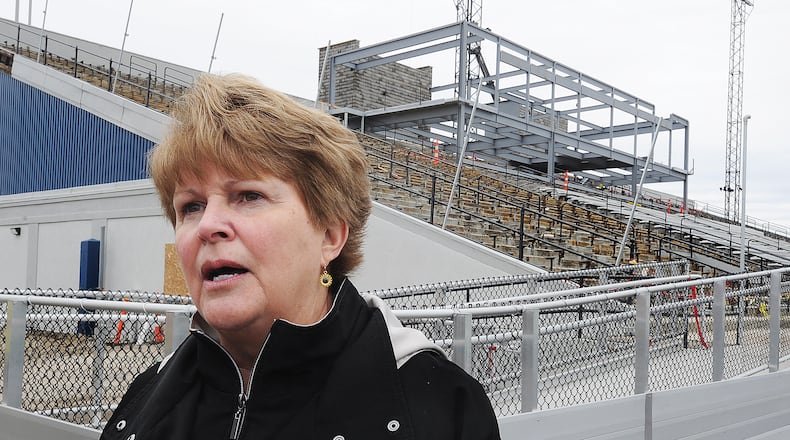Liberal and conservative education policy groups and teachers’ unions alike say that, while high, superintendent salaries are fair. Superintendents often come with decades of experience in teaching, work long hours, are required to get a higher education degree and don’t take summers off.
But some question the perks.
“Pension pick ups, where the employer pays both the employer and employee share of public pension contributions, are particularly questionable and generally shouldn’t be done,” said Greg Lawson, spokesman for the Buckeye Institute, a conservative think tank in Ohio.
“They certainly should not be layered on top of already large triple-digit salaries.”
The Dayton Daily News is analyzing pay for top school district officials as part of our Payroll Project, which also includes a searchable online database of public employee salaries in the region.
The database currently includes the salaries of public employees who made at least $50,000 and work for the state of Ohio, for a school district in our nine-county region, or for several local counties and cities. More will be added in coming weeks.
“In general, I think most superintendents earn their compensation,” said Aaron Churchill, Ohio Policy director for Fordham, an education policy think tank. “It’s a high-profile, high-pressure job and their leadership truly matters in charting the course of a district.”
Churchill noted that superintendents make decisions about math and reading curriculum, how teachers are hired and paid, and how the district will engage with parents.
“Those types of decisions can make or break a district — and impact the education of students,” Churchill said. “A superintendent that can provide that type of strong leadership, while navigating political challenges, is worth every penny.”
Salary range
Superintendents who work at large districts, like Lakota, Mason, Dayton Public Schools and Beavercreek, were among the highest paid.
The two top earners were also superintendents who held Ph.D.s and worked in districts with a lot of students.
Dayton Public Schools superintendent Elizabeth Lolli made $215,250 in 2022-2023. She’s been superintendent since 2018. Her salary has grown from $175,000 when she first took the superintendent position in 2018. In 2021, when she re-signed her contract, the base salary was $205,000.
Lolli anticipated leaving DPS this year after her last contract was completed, but the board of education voted to extend her contract.
“Superintendents in any school district are the Chief Executive Officers,” Lolli said. “They run school districts of various sizes and I, as one of the Ohio Eight superintendents, with one of the largest districts in the region, make a comparable salary and benefits to others in the state. The Dayton Public Schools has an operating budget of over $542 million dollars per year and has nearly 2,300 employees.”
The Ohio Eight districts are the eight large urban districts in the state and includes Cincinnati, Columbus, Dayton, Akron, Cleveland, Canton, Toledo and Youngstown.
Mason City superintendent Jonathan Cooper made $204,000 last school year, according to his contract. His contract began in 2021 and will end July 31, 2026, with increases in compensation to be agreed upon by the board of education and superintendent. His base salary was $200,000 in 2021.
On the lower end of the salary range are districts like New Lebanon and Bellbrook-Sugarcreek. Bellbrook-Sugarcreek superintendent Doug Cozad made $133,000 last school year, while New Lebanon superintendent Greg Williams made $120,297.
Ohio Education Association president Scott DiMauro said those who work in public schools should be paid fairly, reflecting the value that public education has for all students.
“As pay rates are adjusted with experience, we advocate for ensuring teacher and education support professional pay to address the need to attract and retain qualified people in every classroom and schoolwork site across the state,” DiMauro said. “OEA is not involved in negotiating compensation for administrators, but we do believe adjustments to management salaries should be proportionate to compensation negotiated for the members we represent.”
Tanisha Pruitt, a state policy fellow at Policy Matters Ohio, a liberal think tank, said she understood that many factors go into calculating superintendent pay and districts want to attract qualified individuals, but argued that there should be a cap on the amount of money district leaders and administrators make.
“Capping the pay for superintendents can help districts redirect some of those funds into the classrooms to provide more stipends for teachers to use for school supplies, so that they do not have to pay out of their own pockets and could help teachers get the much needed raises they deserve so that they can have the resources and support that they need and we can keep educators in our classrooms,” Pruitt said.
Other kickbacks
Almost all superintendents had in their contracts that the board of education would pay their share and the employee share of STRS retirement.
STRS is Ohio’s public teachers’ retirement account. Public school employees pay 14% of their earnings, and the school districts they work for also pay 14% of their earnings into the system.
That means for a superintendent who makes $164,000 — roughly the average number for local superintendents — the district is paying about $45,000 towards their retirement fund, or about $22,960 that the superintendent does not have to pay.
Some superintendents, including Mason and Dayton, also had an annual sum of money set aside in a deferred compensation account. Cooper’s contract states that the amount would start at $6,000 in 2022 and rise by $1,000 each year. Beginning next year, Lolli’s contract agrees to a $35,000 contribution.
Pruitt said superintendent benefits, like salaries, should also be capped to send district funds towards educators and kids.
“When districts make decisions on what to pay superintendents, they need to first consider what their students and schools need most, so that we can truly make Ohio one of the best states to educate a child,” she said.
About the Author




